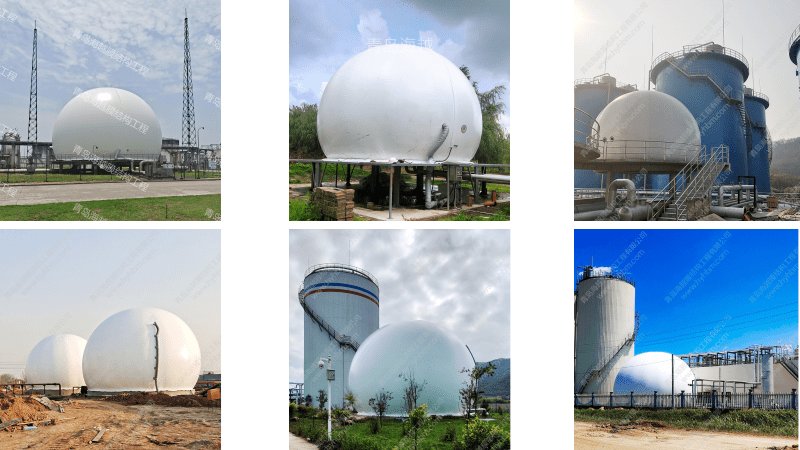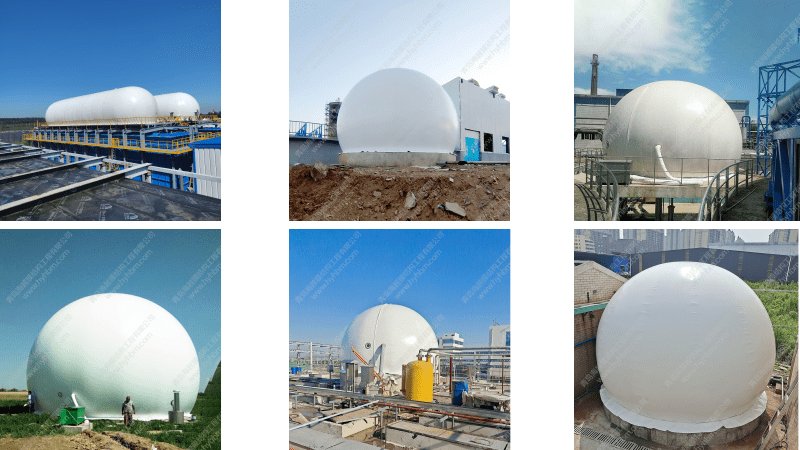The Importance of Biogas Holders in Anaerobic Digestion Systems
Biogas holders play a critical role in maintaining the stable operation of anaerobic digestion systems. Whether fixed, floating, or inflatable, these essential components are indispensable in ensuring efficient gas management within the process.
This article explores the functions and development of biogas holders, with a particular focus on the widely used double membrane gas holders. By understanding their working principles and advantages, customers can gain a comprehensive insight into modern biogas storage solutions.

Types of Gas Holder Roofs and Their Importance:
Fixed Covers:
Fixed covers are commonly seen in early anaerobic digester designs, especially in wastewater treatment plants. These covers do not provide gas storage capability themselves and therefore require a separate biogas holder. When internal pressure rises within the digester, gas is vented into the external gas holder for storage.
Floating Covers:
Floating covers automatically adjust their position based on the volume of gas and sludge inside the digester. They use their own weight to maintain gas pressure and feature a skirt structure around the perimeter to create a seal. This sealing method is similar to that of traditional gasometers, where a liquid seal medium ensures safe gas containment inside the vessel.
Flexible Inflatable Membrane Covers:
This is the most widely used structure in commercial anaerobic digestion systems. Featuring a double-layer membrane design, it offers excellent insulation to reduce heat loss. By adjusting the air pressure between the inner and outer membranes, the system can flexibly control biogas storage and balance gas production with consumption. The air pressure control system maintains a stable pressure differential, ensuring safe and continuous operation.

Development History of Biogas Holders:
Traditionally, steel and concrete were the main construction materials for gas storage tanks. These materials were used in various gas holder designs, such as steel floating roof holders and bell-over-water type gasometers. However, as biogas technology evolved, the industry realized the need for a more reliable and low-maintenance gas storage solution.
The emergence of double membrane biogas holders in the 1980s revolutionized the field. These systems utilize high-performance membrane fabrics originally developed in the architectural sector, offering excellent gas tightness and durability. With the development of dense PVC coatings, membrane performance was further enhanced — providing superior corrosion resistance and requiring minimal maintenance. As a result, double membrane gas holders have become the preferred choice for modern biogas storage systems.
Lifespan and Replacement Cycle of Double Membrane Gas Holders:
The typical service life of a double membrane gas holder ranges from 10 to 20 years, depending on factors such as membrane quality, maintenance practices, and environmental conditions. To maximize system longevity, it is essential to conduct regular inspections, follow the manufacturer’s maintenance guidelines, and carry out timely repairs when necessary.
Advantages of Qingdao Haiyue Double Membrane Gas Holders
Stable Structure and High Safety
Haiyue’s double membrane gas holders adopt an inner and outer membrane design. The outer membrane provides structural stability, while the inner membrane stores biogas, ensuring safe and reliable operation under various working conditions.
High-Performance Membranes with Excellent Durability
Made from high-strength PVC-coated fabric imported from Germany, the membranes offer outstanding resistance to UV rays, acids, and corrosion. They feature excellent gas-tightness, effectively preventing biogas leakage.
Efficient Thermal Insulation and Energy Saving
The dual-membrane structure forms an insulating air layer that reduces heat loss, helps maintain a stable temperature in digesters, improves gas production efficiency, and contributes to energy savings and emission reduction.
Automated Control System for Intelligent Operation
Equipped with advanced PLC control systems and pressure sensors, the gas holder automatically adjusts inter-membrane pressure and monitors system performance in real-time, achieving intelligent management.
Easy Installation and Low Maintenance
With modular design and minimal foundation requirements, the system is quick to install and occupies minimal space. It operates with little to no maintenance, significantly reducing operational costs.
Strong Adaptability for Various Anaerobic Systems
Widely suitable for wastewater treatment, agricultural biogas, food waste digestion, and livestock manure fermentation projects. Proven track record in diverse applications both domestically and internationally.
Proven Technology with Rich Experience
With over 20 years of expertise in membrane structure technology, Qingdao Haiyue offers tailored solutions backed by experienced design, production, and installation teams, along with reliable after-sales support.
High Cost Performance and Timely Delivery
Owning its own production facilities and implementing strict quality control, Haiyue ensures high product quality, competitive pricing, reliable lead times, and responsive customer service.